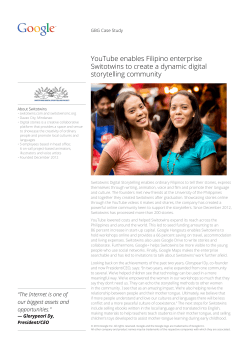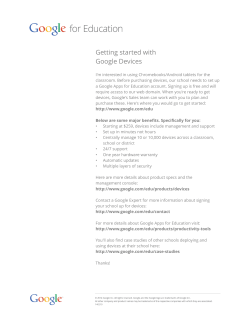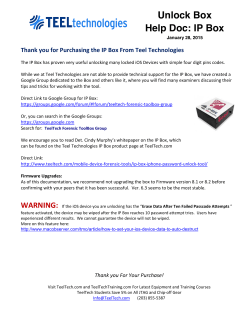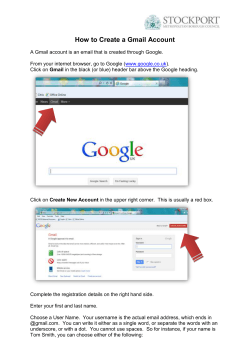
to Read the Latest Byte
CSRA RESA’S TECHNOLOGY NEWSLETTER FEBRUARY 2015 Byte-Sized Bits In This Issue: Techy Teacher Feature Director’s Message Student Spotlight LDC Update Jeff Anderson’s Visit SPOTLIGHT LESSONS: Submit Your Engaging Literacy & Math Lessons to Our Web Library! mstout@csraresa.org Interact with CSRA RESA: www.csraresa.net D’Lee Pollock-Moore, Thomson High Teacher, Engages Students with Google Apps for Education, NoRedInk, & QR Codes D’Lee Pollock-Moore, formerly a Bryan County teacher, proudly teaches English at Thomson High School. Go Bulldogs! In her nine years of teaching, she has been recognized as a STAR Teacher three times. She has served as a mentor for an Eagle Scout and has been recognized twice by the Savannah Morning News as a Teacher of Excellence. She and her husband, David, enjoy restoring an historic home. D’Lee also co-owns an arts and crafts business, Hippy and Preppy Designs. (continued on page 3) Save the Date! Sarah Cordova Graham Fletcher TKES/LKES February 6, 2015 Your Opinion Counts! Writing for K-5 Students FULL February 12, 2015 Engaging Math Students Gr. 6-10 FULL February 10, 2015 GADOE Offers Support Sessions for Leaders 8:30-3:30 8:30-3:30 10:00-12:00 BYTE-SIZED BITS FEBRUARY 2015 From Executive Director: Gene Sullivan, CSRA RESA Happy Presidents’ Day! February 16, 2015 Digital Learning- The Fourth Basic Reading, writing, arithmetic and digital learning…the new fourth basic needed to navigate the world of learning in the 21st Century. According to Wikipedia, “A digital literate person will possess a range of digital skills, knowledge of the basic principles of computing devices, skills in using computer networks, an ability to engage in online communities and social networks while adhering to behavioral protocols, be able to find, capture, and evaluate information, have an understanding of social issues raised by digital technologies and possess critical thinking skills.” Digital literacy is an important topic because technology is changing faster than society. The Internet is the new Wild West where the concept of “buyer beware” takes on a new meaning. The unrestricted Internet is fraught with danger, the least of which is forever capturing the innocence of those foolish enough to post personally sensitive information on a social media website. The rules of appropriate behavior in these digital contexts need to be Lesson 101 for this new curriculum. Digital literacy is about learning to use the most powerful tools we have ever built. What would our schools look like if we were to fully embed digital literacy into our PK-12 curriculum? The ability to embed learning digital skills, alongside what we might think of as traditional skills, across the whole curriculum is certainly something to think about. Mark Surman, Executive Director of The Mozilla Foundation, argues that skills, such as these, are as important as learning to read and write. Becoming literate in how the technical world works is equivalent to learning reading, writing and arithmetic. We need to look at this fourth literacy as mainstream. If we want our kids to be smart and safe in the digital world, whether in school or out of school, having them understand how technology works is basic and essential. March Techy Teacher ~ Lynda Moore Lynda Moore, the Mathematics Department Chair at Burke County High School, is our Techy Teacher for March. Be sure to read her story next month! We are currently seeking a Techy Teacher for May 2015. If YOU would like to share your techy lesson or nominate someone, contact Sandy Woods, swoods@csraresa.org 2 2 1 BYTE-SIZED BITS Techy Teacher Feature I can remember the day that my family finally purchased a personal computer for our own home after owning a typewriter for many years. It seemed like everyone else in the world already had a computer except for me. It was 1999; I was a junior in high school, and AOL, dial-up, and instant messaging was still widespread. Our whole family shared the one computer until I graduated high school. As Bob Dylan said, “Times, they are a-changin,’” and, thankfully, they have in many ways, and the advent of more innovative and interactive technology has significantly altered teachers’ instructional practices, our communication procedures, and our students’ conceptions of the world. I have found that for my classroom and with my students, technology is a vehicle that always engages them in their own learning and helps them take responsibility for their own knowledge acquisition. Technology can change the classroom from a teacher-centered “sit and get” zone to a studentcentered active learning, differentiated environment. One of my favorite tech-savvy tools is the Google Apps for Education collection. I love using Google Docs and Google Drive as a way to give each student individualized attention on writing instruction. In the past, I thought that differentiating writing assignments was allowing each student to write about a different topic or assigning different goals. Google Apps allow me to take writing instruction to a new level. Students can create a Google Doc, share it with me and with my co-teacher. Then, we are able to review every paper and give students recommendations and suggestions as to how to improve their writing by using the commenting, suggesting, and editing features. We’re not using the old school method of red ink to mark every grammar error either; we actually help students improve how they are thinking, how they have created those thoughts in their Google Doc, and how they can improve more cogent issues such as diction and style. This process also allows for better flexible grouping because we can group students with similar writing deficiencies, or we can use our knowledge from their Google Docs to heterogeneously mix students so they can help each other. One of my favorite uses of Google Apps is that it saves time; I can use my class time commenting on each student’s work, while my co-teacher walks around and facilitates or offers individualized help. My current coteacher Coach Crystal Strickland deserves many kudos for how we collaborate and make this system happen! Another advantage of Google Docs and Google Spreadsheets is that we can use the data collected from the comments we are making and the grammar errors that each student is making to assign specific, differentiated grammar lessons on noredink.com, a unique grammar app that helps each student master deficiencies. Noredink can be used through a student’s Edmodo account or as a stand-alone app. One of the best features about using Google Apps is sharing and collaborating. My co-teacher and I can also use the apps to collaborate on shared lesson plans, data collection, and flexible grouping assignments by having the ability to access and work on the same document at the same time. Not only is this practical for teachers, but it is also important for students. They need to learn cloud computing and collaborative writing because they will need this skill in the future. I do assign students group writing assignments to teach collaboration, which works perfectly with “ELACC11-12W6: Use technology, including the Internet, to produce, publish, and update individual or shared writing products in response to ongoing feedback, including new arguments or information.” Google Apps is the easiest way to teach this standard. Once the product is shared with the teacher, he or she can use the File/See revision history feature to see how much each student has contributed to the collaborative piece.This is an excellent tool to prevent plagiarism. Some of my other favorite instructional technology tools are StudyBlue, a flashcard app for smart phones; Edmodo, a social media site for classroom instruction; Remind 101, an anonymous texting app that allows teachers to send mass texts to students and parents, Wordpress, a blogging platform that teachers can use to communicate class lessons to students, parents, & teachers; and QR Codes, which can easily be created and have multiple purposes: scavenger hunts, field trips, Open Houses, and as stickers on students’ desk for quick access to necessary resources. If you would like more information, please visit my teaching blog at www.dleepollock.com. Regardless of where you teach or who you teach, technology is a fun and engaging way to allow students to be more involved in their own learning process. You may struggle with wi-fi issues or device issues; you may only have one iPad for the whole class to share, but you can make something work for you and the students entrusted in your care. Stay techie, CSRA! ~ D’Lee Pollock-Moore 3 FEBRUARY 2015 BYTE-SIZED BITS FEBRUARY 2015 Student Spotlight: Taliaferro County High School Senior, Shanterrica Stephens, Aims for West Point Shanterrica Stephens dreams big! An outstanding senior at Taliaferro County High School, Shanterrica hopes to make a difference in the world. This intelligent, energetic, and hardworking girl has lived her entire life in Taliaferro County. She has attended the same school since Pre-K, yet when she received a Congressional Nomination from Congressman Paul Broun to apply to a school 900 miles from home, she was ecstatic! She plans to pursue a military career and major in sociology in college, so attending the United States Military Academy is her hope for the future. “I know people can come from small places and do great things. I’ve seen it happen,” she confidently said. Shanterrica admits that leaving her family and friends will be difficult, but they are excited about this opportunity she has earned. For now, she will concentrate on completing schoolwork and college applications, playing basketball, and running track. In her spare time, Shanterrica works part-time in nearby Washington, GA. Interviewing the focused, cheerful student for CSRA RESA’s first Student Spotlight was a delight! We wish her the best as she strives to achieve her goals. ~ S. Woods Jeff Anderson Trains Teachers for CSRA RESA Jeff Anderson, a renowned national writing trainer, entertained a roomful of teachers on January 15, 2015. Each participant received two of Anderson’s newest books on how to teach grammar: Mechanically Inclined and Everyday Editing. Anderson began the morning speaking of Invitational versus Dis-Invitational Grammar. For example, DOLs, those hideous sentences that boast ten or more errors and sap ten or more minutes from a class period, are dinosaurs and need to be left in the past. DOLs dis-invite students to engage in grammar, filling students with boredom and, worse, dread. Grading papers is hardly different. “What do teachers do after students put words down on a page?” asks Anderson. They hunt for errors instead of looking for what makes good writing: attitude, knowledge, and skill. According to Anderson, a recent study shows that teaching formal grammar has a negative, even harmful, effect. Interestingly, a study from 1963 showed the same thing! “It’s time to follow the brain research and help students learn the patterns of good writing,” exhorts Anderson. Grammar should focus on function, practical application, and alternative procedures or methods. “We must invite kids to pay attention to language in new ways,” says Anderson. What does he suggest? We should use CORRECT sentences. What’s the worst thing that could happen? The kids could begin to burn correctness into their visual stores. Studying correct sentences also creates a bridge of conversation that will help students remember the grammatical structure. Grammar and writing are inseparable: Writing is the reason for grammar. Rather than approach grammar with a sense of stoicism and compliance, Anderson invites us to rediscover the wonder and joy of a well-crafted (and grammatically correct) sentence. ~ K. Flanders 4 BYTE-SIZED BITS FEBRUARY 2015 Literacy Design Collaborative News ~ C. Sligh A common problem expressed by teachers who only have their students for nine weeks or one semester is that they have a limited amount of time to teach all the required standards. They understand how important it is to incorporate literacy skills in their teaching, but they simply cannot spare 2-4 weeks to complete a full LDC module. Lisa Hollenbach offers a possible solution in her blog “Making Time for Instruction That Works.” “An LDC module represents an investment that pays big dividends; however, when time constraints stand in the way of engaging in a full module, teachers can implement the stand-alone mini-task as a compromise that keeps students grounded in strong literacy practices that are more frequent without the time commitment of the full module implementation. This is a compromise that embeds LDC into our instruction throughout the year in a way that meets teachers where they are and engages students in rigorous discipline-specific reading and writing in every class. Mini-tasks are “on-ramps” to deeper work over time and require the same close reading and rigorous thinking that are inherent in an LDC module. A mini-task is a “bite-sized” portion of LDC that can be used: • To sharpen particular literacy skills or to remediate deficiencies • To plan a single lesson or a sequence of lessons • To formatively assess student literacy skills. Here are a few of my favorite mini-tasks, which you can find in the LDC Core Tools Curriculum Library. Use them as is or take advantage of the LDC Core Tools copy feature and make them your own! • Cartoon Analysis by Susan E. Herrington & Michelle R. Tureau • Close Reading Routine by Michelle L. Lewis • Primary Source Graphic Organizer by Susan Weston, Justin R. Bailey, Chris Crouch, & Rachel McCormick • Reading Photographs by LDC Mini-tasks offer an excellent way to: introduce teachers to LDC and the College and Career Readiness Standards, bring more focused disciplinary literacy practices into the classroom across all courses, and ultimately, improve teaching and learning. This is instruction that works and something for which I believe that teachers can make time.” To read Hollenbach’s complete blog, go to https://ldc.org/blog/posts/making-time-instructionworks UPCOMING LDC TRAININGS – DAYS 3 and 4: COLUMBIA COUNTY HIGH SCHOOL COHORT – FEB. 2-3 RICHMOND COUNTY COHORT – FEB. 9-10 Remember to Use SLDS for Resources & Student Data! Visit Our Homepage for Milestones Updates: www.csraresa.net
© Copyright 2025











